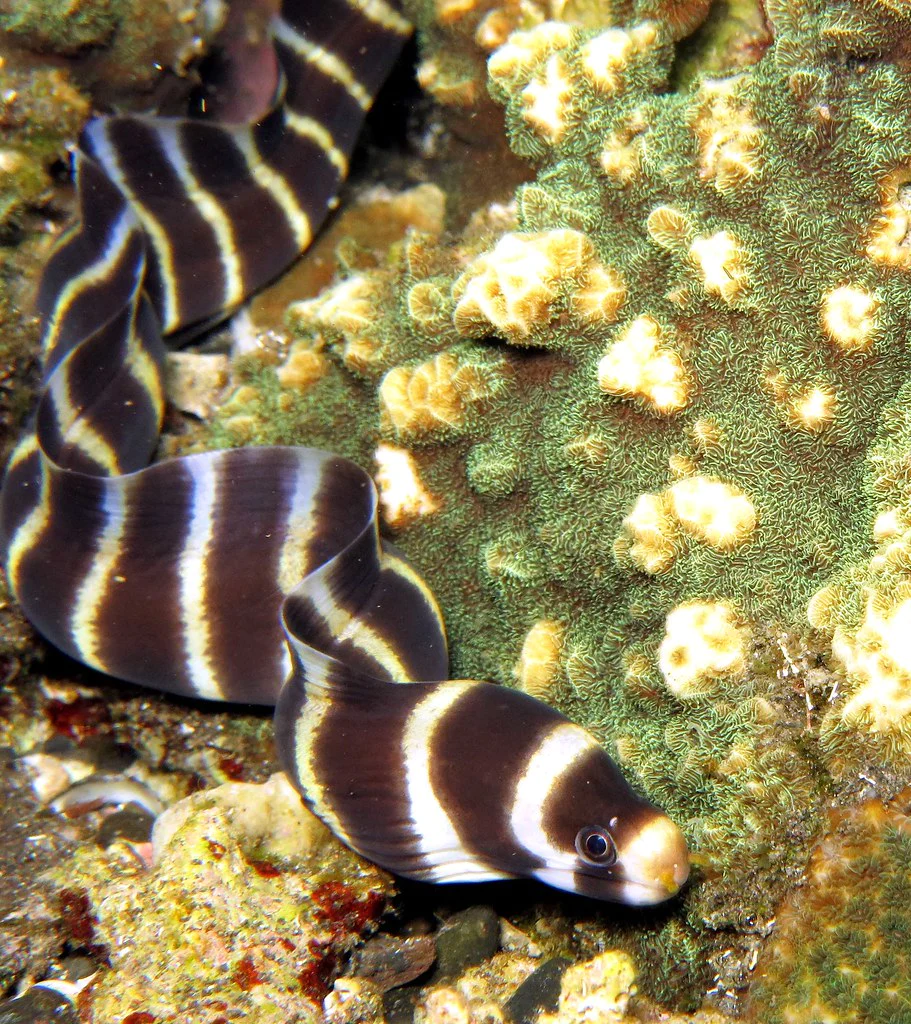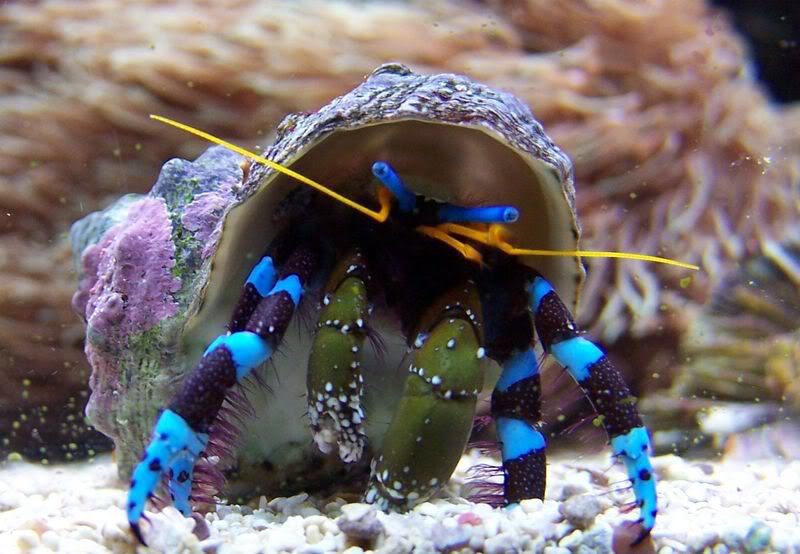Lionfish Exhibit
Volitan Black Lionfish
Diet: Carnivore including small fish, invertebrates and mollusks
Weigh: 1-2 pounds
Size: 18 inches
Life Span: 5-15 years
Lionfish are also known as Zebrafish, Firefish, Turkeyfish, Tastyfish or Butterfly-cod.
Lionfish have conspicuous coloration with the bold contrasting stripes and wide fans of spines. This allows others to know that they can defend themselves. Their fin rays are venomous and can harm humans if injected into the body, though rarely does it cause death.
Lionfish are considered one of the most aggressively invasive species. They are the biggest threat to the Caribbean and Florida coral reef ecosystems because they have few natural predators and are eating the smaller reef fish which helps provide the wealth fare and health of the corals from overbearing algae.
Filefish

Range: Atlantic, Pacific, and Indian Oceans
Diet: Omnivores including algae and benthic invertebrates
Size: Most species are less than 24 inches
Life Span: 4-6 years
Filefish are part of the same family as triggerfish, pufferfish and trunkfish
They are called filefish because of their rough non-overlapping scales with small spikes.
They have two spines on their head. They are able to extend one spine and the second spine is used to lock that first spine into place. They are able to erect the dorsal spine and pelvis simultaneously to make it more difficult for a predator to remove the fish from a cave.
Banded Eel

Range: Indo-Pacific Ocean
Diet: Carnivore including shrimp, crabs, isopods and polychaetes
Size: 28 inches
Life Span: 8-12 years
Eels have small circular gills so the eel has to open and close its mouth for sufficient water flow over their gills.
Eels have poor eye sight but excellent smell. They will wait and hide in the crevices of rocks waiting for their prey to come near.
Eels have a second set of jaws called pharyngeal jaws which are found in their throat. They latch onto their prey with their outer jaws, push forward their pharyngeal jaws to grasp the prey, and then pulls it back into their throat and stomach.
Snowflake Eel

Range: Indo-Pacific Ocean and Eastern Central Pacific Ocean
Diet: Carnivore including shrimp, crabs, isopods, and polychaetes
Size: 20-39 inches
Life Span: 4 years
Eels have small circular gills so the eel has to open and close its mouth for sufficient water flow over their gills.
Eels have poor eye sight but excellent smell. They will wait and hide in the crevices of rocks waiting for their prey to come near.
Eels have a second set of jaws called pharyngeal jaws which are found in their throat. They latch onto their prey with their outer jaws, push forward their pharyngeal jaws to grasp the prey, and then pulls it back into their throat and stomach.
Black Edge Moray Eel

Range: Western Atlantic Ocean
Diet: Carnivore including shrimp, crabs, isopods, and polychaetes
Size: 24 inches
Life Span: 10 years
Eels have small circular gills so the eel has to open and close its mouth for sufficient water flow over their gills.
Eels have poor eye sight but excellent smell. They will wait and hide in the crevices of rocks waiting for their prey to come near.
Eels have a second set of jaws called pharyngeal jaws which are found in their throat. They latch onto their prey with their outer jaws, push forward their pharyngeal jaws to grasp the prey, and then pulls it back into their throat and stomach.
Black Tang

Range: South Pacific Ocean
Diet: Omnivore including algae, mysis shrimp and brine shrimp
Size: 8 inches
Life Span: 7-10 years
They are considered a rarity in the aquarium hobby and can go anywhere between $600-$1500, depending on size.
The distinctive characteristic of this family is the scalpel-like scale that has been modified at the base, the peduncle, of the tail. There may be one or two of these very sharp scales depending on the individual which helps protect these fish from danger. They have small mouths that have one row of teeth to allow them to graze on algae.
Featherduster

Range: Hawaii and Indo-Pacific
Diet: Omnivore including microorganisms
Size: Up to 7 inches
Life Span: 1-2 years
Featherdusters are marine polychaete tube worms with protruding feathery branchiae. They build tubes around themselves out of a touch exudate that is strengthened with sand and bits of shell. Some species will secrete the tube of calcium carbonate instead. The feathery tubes allow them to filter feed and it can retract into the tube if it senses danger.
Blue Legged Hermit Crab

Range: Caribbean Sea
Diet: Detritivore including dead plants and animals and algae
Size: 1 inch
Life Span: 2 years
The Blue Legged Hermit Crab sifts through the sand looking for food. In the aquarium world they are considered to be part of the cleanup crew
They change shells and if they cannot find one then they will temporarily hide by an anemones foot for protection. They also molt their exoskeleton as they continue to grow.
Brittle Star

Range: Found in all major marine provinces from poles to tropics
Diet: Detritivores including dead plants and animals and small crustaceans and worms
Size: Up to 24 inches
Life Span: 5 years
Brittle Stars are closely related to Starfish. They have five long, slender, flexible arms that they can use to move themselves around and all of their internal organs never enter the arms like they do in the starfish. The underside contains the mouth which has five jaws and it serves as the butt as well.
They have tube feet and instead of blood, they use sea water to circulate oxygen through their body.
Astraea Turbo Snail

Range: Western Atlantic Ocean
Diet: Herbivore including algae
Size: Up to 2.5 inches
Life Span: 3-5 years
Sea Snails are part of the cleanup crew in aquariums because they eat the algae. They breathe through gills. They also have an operculum which is like a trap door that protects them inside their shell from outside predators. Shells are spirally coiled and their growth rate depends on the temperature, depth, and isotopic oxygen levels in the water, and how much food is available for the snail.
Coral

Range: Coral reefs are found in warm shallow water. There are corals in depths up to 300 feet.
Diet: Carnivore. Depending on the polyp they can eat anything between a zooplankton to small fish
Size: Each polyp is a few millimeters in diameter and a few centimeters high. Over generations the colony creates a skeleton that can measure up to several meters across.
Life Span: Individual polyps can live between several years to over 500 years depending on species
Corals are marine invertebrates that live in compact colonies of identical individual polyps. They have tentacles that can sting and bring their food to their stomach. Once they are done digesting, they expel their waste through the same hole as their mouth.
There are two types of corals. Hard corals live in colonies are look like rock-like formations. Soft corals look like plants.
Corals have a symbiotic relationship with zooxanthellae that photosynthesizes and gives the coral energy, nutrients and color.
Under high stress the polyps of the coral will expel the zooxanthellae going through a bleaching event. This increases their chance of survival for a short time but if the stress persists then the polyp can die.
Coral reefs have an extreme diverse ecosystem which can host over 4000 species of fish, cnidarians, mollusks, crustaceans and many other animals
Gorgornian Coral

Range: Abundant in Western Atlantic
Diet: Photosynthesis and zooplankton
Size: Several feet high and across
Life Span: 4 to 12 years for individual polyps
Gorgornian corals are soft corals known as sea fans and sea whips. They are brightly colored often, purple, red, or yellow. Gorgornians have minute spiny skeletal elements that five them some support and gives them a spiky grainy texture to deter predators.
Each Gorgonian polyp has eight tentacles to filter feed. They also have the symbiotic relationship with zooxanthellae that photosynthesizes and gives the coral the nutrients, energy, and color that it receives.
Gold Hammer Coral

Range: Australia
Diet: Photosynthesis, mysis and brine shrimp
The Gold Hammer Coral is considered a LPS coral which stands for Large Polyp Stony Coral. It’s a marine invertebrate, called a polyp that live in compact colonies. Hard corals live in colonies that look like rock formations. All corals have a symbiotic relationship with zooxanthellae that photosynthesizes and gives the coral energy, nutrients, and color.
They have potent sweeper tentacles that can reach up to 6 inches and will sting anything within reach of its nematocysts including other coral colonies. Its tentacles resemble hammers which is why it’s called a hammer coral.
Green Hammer Coral

Range: Pacific Reefs
Diet: Photosynthesis, mysis and brine shrimp
Length: Some colonies can reach over 3 feet
The Green Hammer Coral is considered a LPS coral which stands for Large Polyp Stony Coral. It’s a marine invertebrate, called a polyp that live in compact colonies. Hard corals live in colonies that look like rock formations. All corals have a symbiotic relationship with zooxanthellae that photosynthesizes and gives the coral energy, nutrients, and color.
They have potent sweeper tentacles that can reach up to 6 inches and will sting anything within reach of its nematocysts including other coral colonies. Its tentacles resemble hammers which is why it’s called a hammer coral.
Red Leaf Plate Montipora

Range: Indo-Pacific Region and Red Sea
Diet: Photosynthesis and zooplankton
Red Montipora is considered to be SPS. SPS stands for Small Polyp Stony Coral. It’s a marine invertebrate, called a polyp that live in compact colonies. Hard corals live in colonies that look like rock formations. All corals have a symbiotic relationship with zooxanthellae that photosynthesizes and gives the coral energy, nutrients, and color.
This coral forms flat, plating colonies that expand by adding to their foundations and spreading out further. The individual polyps are transparent and reside within the small bumps on the surface to emerge at night.
Green Montipora

Range: Indo-Pacific Region and Red Sea
Diet: Photosynthesis and zooplankton
Green Montipora is considered to be SPS. SPS stands for Small Polyp Stony Coral. It’s a marine invertebrate, called a polyp that live in compact colonies. Hard corals live in colonies that look like rock formations. All corals have a symbiotic relationship with zooxanthellae that photosynthesizes and gives the coral energy, nutrients, and color.
This coral forms flat, plating colonies that expand by adding to their foundations and spreading out further. The individual polyps are transparent and reside within the small bumps on the surface to emerge at night.
Rock Flower Anemones

Range: Caribbean
Diet: Carnivores including mysis shrimp, small fish and mussels
Length: 8 inches
Life Span: 80 years
Rock Flower Anemones come in many different colors with the oral disc usually being a different color than the rest of the anemone and it lacks tentacles. The tentacles are located on the outer parts and appear beaded. They prefer to bury most of their body in the substrate with only the oral disc and tentacles showing.

